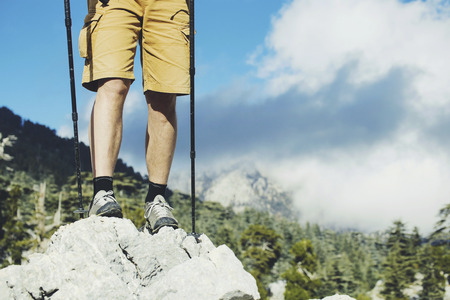Introduction to Walking in the UK Countryside
There’s a singular magic to walking in the British countryside, where every footstep is steeped in history, natural beauty, and a dash of unpredictable adventure. Imagine striding out across the misty fells of the Lake District, scaling the rugged trails of the Scottish Highlands, or tracing the dramatic edges of Cornish coastal paths as Atlantic winds whip at your jacket. Each landscape tells its own tale—ancient stone walls criss-crossing sheep-dotted moors, wildflower meadows bursting with colour after a summer rain, and pathways that meander through sleepy villages straight out of a storybook. Yet for all their charm, these quintessentially British terrains come with their fair share of hidden dangers. Sudden downpours can turn a gentle ramble into a mud-splattered slog; rocky descents test even the hardiest ankles; and ever-changing weather means you’re never quite sure what’s around the next bend. In this article, we’ll delve into some of the most common injuries walkers face on these beloved routes—and more importantly, how you can prepare yourself to sidestep mishaps without missing out on any of the adventure.
2. Twisted Ankles and Sprains on Uneven Terrain
If you’ve ever braved a windswept ridge in the Lake District or picked your way across the boggy moorlands of Dartmoor, you’ll know that the British countryside is no tame playground. Rocky footpaths, unpredictable tussocks, and slippery stiles can transform a gentle stroll into an extreme test of balance and resilience. It’s little wonder twisted ankles and sprains top the list of walking injuries reported by ramblers all over the UK.
Common Hazards Underfoot
| Terrain Type | Typical Risks |
|---|---|
| Rocky Paths | Loose stones, hidden holes, uneven surfaces |
| Boggy Moorlands | Sinking mud, concealed dips, slick grass |
| Wooden Stiles & Gates | Wet or mossy steps, unstable platforms |
The Importance of Kit: Boots That Mean Business
The right footwear isn’t just about looking the part—it’s your frontline defence against disaster. Seasoned hikers swear by sturdy boots with proper ankle support, grippy soles, and waterproofing. Leave your trainers at home; British weather is as fickle as the ground beneath your feet.
Features to Look for in Walking Boots:
- Ankle-high support to prevent rolling
- Vibram or deep-lugged soles for traction
- Waterproof membranes (e.g., Gore-Tex)
- Cushioned insoles for shock absorption
Cautious Footwork: Your Secret Weapon
No amount of gear can replace good technique. Take deliberate steps on tricky terrain—scan ahead for hazards and use walking poles if needed. When crossing stiles or hopping rocks, keep your weight centred and avoid rushing; haste is often the undoing of even the hardiest walker.
Pro Tip:
If you do go over on your ankle, follow RICE—Rest, Ice, Compression, Elevation—and seek medical help if pain persists. Remember: prevention starts with respect for the land beneath your boots.

3. Weather Woes: Hypothermia, Heat Exhaustion, and Sunburn
If you’ve ever braved the wilds of the British countryside, you’ll know that the weather here is nothing short of legendary – not for its kindness, but for its sheer unpredictability. One moment you’re striding through a sun-dappled copse, the next you’re battered by a squall straight off the Atlantic. It’s this capricious climate that makes walking in the UK both an adventure and a potential hazard.
The Perils of British Weather
Forget what you think you know about rain; out here, showers can materialise from nowhere, drenching you before you’ve had time to rummage for your cagoule. On other days, heatwaves arrive with little warning, turning gentle strolls into tests of endurance. And let’s not overlook those deceptively bright spring days where UV rays slip past cloud cover to leave you lobster-red by evening.
Hypothermia: The Silent Threat
Even in summer, wind and rain can sap your core temperature frighteningly fast – especially if you’re caught on exposed fells or moorland. Hypothermia isn’t just a winter menace; it lurks whenever wet clothes and wind chill combine. Always pack spare layers – think moisture-wicking base layers, insulating mid-layers, and a robust waterproof shell. Don’t gamble on the forecast; dress for worse than expected and change into dry kit at the first sign of trouble.
Heat Exhaustion: When the Sun Bites Back
Yes, Britain does get hot – occasionally blisteringly so. High temperatures can lead to dehydration and heat exhaustion quicker than you’d imagine, especially when shade is sparse on open downs or ridgelines. Carry plenty of water (more than seems necessary), take regular breaks in whatever shade you can find, and pace yourself during peak hours. A wide-brimmed hat and lightweight clothing are as vital as your trusty boots on these rare scorchers.
Sunburn: The Underestimated Enemy
Cloud cover often lulls walkers into complacency, but ultraviolet rays penetrate even on overcast days. Sunburn isn’t just uncomfortable – repeated exposure increases your risk of skin cancer down the line. Apply high-factor sunscreen liberally and frequently, don sunglasses with proper UV protection, and consider long sleeves if you’re out all day.
Key Takeaway: Prepare for Everything
The best defence against Britain’s meteorological mood swings? Preparation and respect for the elements. Layer up, waterproof up, and slap on that sunscreen – only then can you fully embrace the exhilarating unpredictability that makes UK walking such an extreme adventure.
4. Trips and Falls: Navigating Stone Walls, Mud, and Stiles
If you’ve ever tackled the wild heart of the Lake District or braved a blustery ramble along the South Downs, you’ll know that classic British countryside is riddled with hazards that turn a gentle stroll into an adventure challenge. The notorious trio—crumbling dry stone walls, slick muddy slopes, and those devilishly awkward wooden stiles—are responsible for countless twisted ankles and bruised egos every year. Let’s break down these obstacles and arm you with essential tactics for staying upright.
Countryside Obstacles: What You’re Up Against
| Obstacle | Common Risks | Safety Tactics |
|---|---|---|
| Dry Stone Walls | Loose stones, unexpected drops, unstable footing | Only cross at designated gaps or steps; check stability before putting weight down; avoid climbing over wet or mossy stones |
| Muddy Slopes | Slipping, sliding, loss of traction | Wear walking boots with solid grip; take smaller steps; use trekking poles for balance; skirt around visibly boggy patches when possible |
| Wooden Stiles | Slick surfaces, uneven steps, wobbling handrails | Face the stile while crossing; maintain three points of contact (hands and feet); step deliberately; test each plank for give before shifting full weight |
Tactical Tips for Safe Negotiation
- Pace Yourself: Don’t rush—haste leads to mistakes. Survey each obstacle calmly before committing.
- Maintain Your Centre of Gravity: Keep your body weight low and over your feet, especially on unpredictable terrain.
- Use What’s Available: Grab onto sturdy fence posts or trees if they’re within reach. If you have trekking poles, plant them firmly before taking each step.
The British Weather Factor
Never underestimate how quickly the weather can change on a UK walk. Rain transforms gentle paths into treacherous quagmires in minutes. Always check forecasts before heading out and be prepared to turn back if conditions deteriorate—no view is worth a broken leg.
The Adventurer’s Mindset
Treat each countryside obstacle as part of the journey’s story—not just something to “get past” but a chance to sharpen your wits and build your trail skills. Mastering these features means you’ll not only avoid injuries but come home with tales worthy of any seasoned rambler.
5. Encounters with Livestock and Wildlife
Britain’s countryside is alive with more than just rolling hills and stone walls—it’s home to herds of cows, flocks of sheep, and a host of wild creatures fiercely protective of their turf. For walkers who crave the thrill of discovery, these encounters can quickly turn from enchanting to hazardous if you don’t tread wisely.
Cows: More Than Gentle Grazers
While cows may seem docile from afar, they’re responsible for more injuries to walkers in the UK than any other farm animal. This is especially true during calving season, when mothers become ultra-defensive. If your route takes you through a field of cattle, keep dogs on a short lead but be prepared to release them if threatened—your pooch can outrun danger better than you can. Stay calm, walk briskly and steadily, avoiding eye contact with the herd. Never get between cows and their calves, and always stick to marked footpaths.
Sheep: Seemingly Harmless, Still Unpredictable
Sheep might look like the softest hurdle on your adventure, but startled ewes—especially those with lambs—can bolt unexpectedly or even charge in rare cases. Respect boundaries by keeping gates closed behind you and never attempt to pet or feed sheep. Give them plenty of space and move quietly through their territory.
Nesting Birds: Defenders of the Skies
From lapwings swooping over moors to aggressive geese near waterways, nesting season (spring through early summer) brings out the warrior in British birdlife. Watch for warning signs about ground-nesting birds and heed any instructions; it’s not just about avoiding pecks—it’s about preserving delicate habitats too. Stick to paths, keep noise down, and retreat calmly if birds become agitated.
Respect Boundaries: Fences, Signs & Gates
The UK’s network of footpaths is criss-crossed with stiles and gates—each one a reminder that you’re crossing into someone else’s domain. Always close gates behind you and obey all warning signs, no matter how tempting a shortcut might seem. These markers aren’t there for decoration; they’re often hard-earned lessons in safety from generations past.
Tough Advice for Adventurers
If you want to conquer Britain’s wild places without incident, bring both courage and respect in equal measure. Scan ahead for livestock before entering fields; if in doubt, choose an alternative route. Keep dogs under control at all times. And above all else, remember: every boundary tells a story—ignore it at your peril.
6. Blisters and Chafing: Keeping Your Feet Happy
If there’s one thing that can turn a glorious ramble through the Cotswolds or a Lake District challenge into a true test of endurance, it’s the dreaded blister—or its sneaky cousin, chafing. Every seasoned UK walker knows the agony of hot spots flaring up halfway through a muddy footpath, threatening to sabotage even the best-laid plans. Let’s dive into why these injuries are so common in the British countryside, and more importantly, how you can sidestep them and keep your feet in fighting form.
Blister Hotspots: Know Your Enemy
Blisters tend to strike where friction is highest—think heels, toes, and the balls of your feet. Long days on uneven trails, especially when your socks get damp from an unexpected downpour or a dew-soaked meadow, create the perfect storm for skin irritation. Once the rubbing starts, it’s a race against time before those painful bubbles rise up.
Chafing: The Hidden Saboteur
Chafing isn’t just limited to your feet; inner thighs and underarms can fall victim too, particularly if you’re covering big distances or carrying a rucksack over rough terrain. The repetitive movement and persistent dampness common in Britain’s ever-changing weather amplify your risk.
Tactics for Prevention: Gear Up Like a Pro
Preparation is your best defence. Start with quality walking socks—preferably merino wool or technical blends designed to wick away moisture. Avoid cheap cotton socks at all costs; they hold onto sweat and ramp up friction. Make sure your boots fit like a glove but leave enough room for your toes to wiggle. If you’re breaking in new boots, take them for short spins before tackling that 20-mile stretch along Hadrian’s Wall.
Before heading out, dust your feet with anti-chafing powder or apply specialist balms to blister-prone areas. Some walkers swear by taping their heels and toes with zinc oxide tape—a trick borrowed from ultra-marathoners facing miles of British bogs and brambles.
Finally, don’t ignore discomfort. The moment you feel a hot spot, stop and address it: swap socks, re-tape, or add a blister plaster before things escalate. Out here in the wilds of Yorkshire or along the windswept coastal paths of Cornwall, happy feet mean unstoppable adventures.
7. First Aid and Emergency Planning
When you’re braving the rugged moors, misty dales, or windswept peaks of the UK countryside, preparation is your best defence against disaster. Every seasoned walker knows that a well-stocked first aid kit is as vital as sturdy boots. For British conditions, your basic kit should include plasters of various sizes, blister pads, antiseptic wipes, sterile dressings, adhesive tape, a small roll of bandage, tweezers for stubborn thorns or ticks, safety pins, painkillers like paracetamol or ibuprofen, antihistamines for stings, and a foil blanket to stave off hypothermia when the weather turns. Don’t forget a whistle and a pencil with waterproof notepaper for signalling and note-taking if technology fails.
Route Planning: The Unsung Hero
Before you set off on an intrepid ramble through the wilds of Dartmoor or the Lake District fells, meticulous route planning is non-negotiable. Study OS maps, check recent trail reports, and always have a paper map and compass to hand—mobile signal can be patchy in remote spots. Identify escape routes and shelter points along your chosen path; even experienced hillwalkers can be caught out by sudden fog or driving rain.
Leave Your Itinerary
This isn’t just for over-cautious types: always leave details of your planned route and estimated return time with someone at home or at your accommodation. If you change plans en route—say, drawn by an enticing summit or shortcut—update someone if possible. This crucial step could shave hours off emergency response times if things go awry.
Knowing When to Call Mountain Rescue
Pride has no place in the wilds when safety’s at stake. If you’re lost, injured, trapped by weather or darkness—or if anyone in your party is immobile due to injury—don’t hesitate: dial 999 and ask for Police then Mountain Rescue. Stay put once help is summoned; trying to self-rescue often makes matters worse. Use your whistle (six blasts per minute) and high-visibility gear to attract attention while you wait for the cavalry. Out here, fortune favours not just the brave but the well-prepared adventurer.

